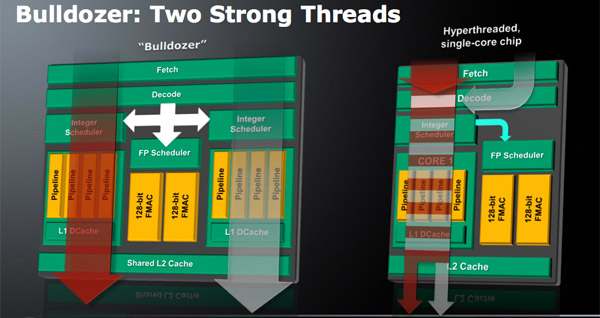AMD Discloses Bobcat & Bulldozer Architectures at Hot Chips 2010
by Anand Lal Shimpi on August 24, 2010 1:33 AM ESTBulldozer
AMD already gave us a good amount of detail on Bulldozer earlier this year. We’ll start with a quick refresher.
With Nehalem, Intel moved to a more modular design process that would allow it the ability to quickly configure different versions of the chip to hit various markets. With Bulldozer, AMD is doing the same.
The basic building block is the Bulldozer module. AMD calls this a dual-core module because it has two independent integer cores and a single shared floating point core that can service instructions from two independent threads. The two thread machine is larger than a single core but smaller than two cores with straight duplication of resources.

All else being the same, it should give you more threaded performance than a single SMT (Hyper Threaded) core but less than two dedicated cores. The savings are obviously on the die side. AMD tells us that the second integer core increases the Bulldozer module die by around 12%, despite significantly increasing performance in threaded integer applications.

Processors may implement anywhere from one to four Bulldozer modules and will be referred to as 2 to 8 core CPUs. Each core appears to the OS as a logical processor similar to what you get with Hyper Threading. A CPU with four Bulldozer modules would appear as an 8-threaded processor under Task Manager in Windows.
AMD argues that the Bulldozer module is ideal provisioning of hardware. With SMT (Hyper Threading) you force too much into a single core, while with traditional multicore you often waste hardware as any idle resources are duplicated across the chip.

Bulldozer CPUs will be AMD’s first 32nm processors manufactured at GlobalFoundries.
The new details today are about everything inside of the Bulldozer module.










76 Comments
View All Comments
Zoomer - Wednesday, August 25, 2010 - link
Basically you'll need 2x the power for much less than 2x performance increase. Modern branch predictors can have very good hit rates ~90%+. It simply made more sense to use the second int unit for another thread.However, if you need the absolutely best single threaded int performance at all costs, imho, what you suggest wouldn't be bad. In fact,
Edison5do - Tuesday, August 24, 2010 - link
Finally besides the price competition, we will be able to see some tech competition, we have to raise our praise for AMD not to reject the ATI btand because New and HiTech CPU´s, should be paired with HiQuality, nice priced, Radeon GPU´s.I really dont think People are ready to see "AMD" Brand as a Head-toHead Competitor to "INTEL" Brand, by this i mean that they should rely on ATI for being well accepted by the public for more time before they even star thinking about that.
angrysand - Tuesday, August 24, 2010 - link
they may have had the on die memory controller, but Atom basically created the netbook market. AMD is just improving on what Intel help create (and that remains to be seen).I had to see AMD go because I like having resonable performance for reasonable price. But they had better get their act together and put out faster CPU's.
ABR - Wednesday, August 25, 2010 - link
Atom did not create the netbook market, some convergence of wireless data and increasing use of the web by non-computer folk did. The first "netbook" products were the Crusoe-based mini-notebooks starting in 2001. Unfortunately for Transmeta, interest in the high-portability / long battery life model was low, only a couple of models even came out, and they ended up having to compete with Intel for scraps of the low-end laptop market. They lost, and Intel only finally caught up with their technology later with the Atom, when, coincidentally or not, the market was finally ready.Nehemoth - Tuesday, August 24, 2010 - link
Why Bodcat will be manufactured in the 40nm process instead of 32nm is cause the GPU?.Why will be manufactured on TSMC instead of GlobalFoundries?.
I supposed that this could be a problem with GF not being ready in 32nm but can we see a switch from TSMC to GlobalFoundries after Bulldozer begin to be manufacture?.
iwod - Wednesday, August 25, 2010 - link
TSMC has much higher 40nm capacity then GF's 32nm. Bobcat is going to be a low end product which will hopefully generate high volume of sales. TSMC in this case will be a much better fit then GF.moozoo - Wednesday, August 25, 2010 - link
I wonder how hard it would be to make a version has two Floating point cores and one integer core.Will AMD have a product to match Intel MIC's (Larrabee) .
(http://www.anandtech.com/show/3749/intel-mic-22nm-...
YuryMalich - Wednesday, August 25, 2010 - link
Hi,There is a mistake on page 5 on this picture http://images.anandtech.com/reviews/cpu/amd/hotchi...
There were drawn two 128-bit FMAC units on Phenom II Microarchitecture.
But K10 processor doesn't have FMAC units at all! It has 1 FMUL and one FADD and one FMISC(FLOAD) units.
The FMAC (multiple-add) units are new in Bulldozer microarchitecture.
Jack Sparow - Wednesday, August 25, 2010 - link
"Ivo August 25, 2010How many threads everyone processor (“Interlagos”, “Valencia” and “Zambezi”) can do simultaneously per core compare with Phenom II processor?
Reply
John Fruehe August 25, 2010
One thread per core."
This quote is from AMD blogs home. :)
silverblue - Wednesday, August 25, 2010 - link
I think I touched on this before once on a THQ news article - John Fruehe is being confusing. The correct definition of a complete Bulldozer core is a module, which is a monolithic dual-integer core package also consisting of other shared resources - the top image on page 4 of this article is a great guide. So, a four module (or quad core as we currently term them) Bulldozer will handle eight threads concurrently as those four cores possess eight integer cores.As such, I don't see non-SMT Bulldozer cores ever coming out.